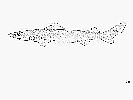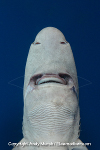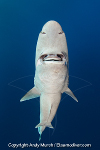Centrophorus granulosus
(Bloch & Schneider, 1801)
Gulper shark
Classification: Elasmobranchii Squaliformes Centrophoridae
Reference of the original description
M.E. Blochii Systema Ichthyologiae iconibus ex illustratum. Post obitum auctoris opus inchoatum absolvit, correxit, interpolavit. J.G. Schneider, Saxo: 584 p., 110 pl.
M.E. Blochii Systema Ichthyologiae iconibus ex illustratum. Post obitum auctoris opus inchoatum absolvit, correxit, interpolavit. J.G. Schneider, Saxo: 584 p., 110 pl.
Image of the original description
No image in first description.
No image in first description.
Synonyms / new combinations and misspellings
Acanthorhinus granulosus, Centrophorus acus, Centrophorus aff. granulosus, Centrophorus cf. acus, Centrophorus cf. granulosus, Centrophorus cf. niaukang, Centrophorus niaukang, Centrophorus robustus, Centrophorus steindachneri, Dalatias acus, Entoxychirus acus, Entoxychirus atromarginatus, Lepidorhinus steindachneri, Squalus granulosus
Acanthorhinus granulosus, Centrophorus acus, Centrophorus aff. granulosus, Centrophorus cf. acus, Centrophorus cf. granulosus, Centrophorus cf. niaukang, Centrophorus niaukang, Centrophorus robustus, Centrophorus steindachneri, Dalatias acus, Entoxychirus acus, Entoxychirus atromarginatus, Lepidorhinus steindachneri, Squalus granulosus
Types
Centrophorus granulosus
Holotype: ZMB: (whereabouts unknown); Neotype: AMNH: 78263;
Centrophorus acus
Holotype: MCZ: 1049-S;
Centrophorus niaukang
Holotype: TFRI: 3612;
Centrophorus robustus
Holotype: ECSFI: E-1170;
Centrophorus steindachneri
Syntype: NMW: 61300;
Centrophorus granulosus
Holotype: ZMB: (whereabouts unknown); Neotype: AMNH: 78263;
Centrophorus acus
Holotype: MCZ: 1049-S;
Centrophorus niaukang
Holotype: TFRI: 3612;
Centrophorus robustus
Holotype: ECSFI: E-1170;
Centrophorus steindachneri
Syntype: NMW: 61300;
Description :
Citation: Centrophorus granulosus (Bloch & Schneider, 1801): In: Database of modern sharks, rays and chimaeras, www.shark-references.com, World Wide Web electronic publication, Version 11/2024
Please send your images of "Centrophorus granulosus" to info@shark-references.com
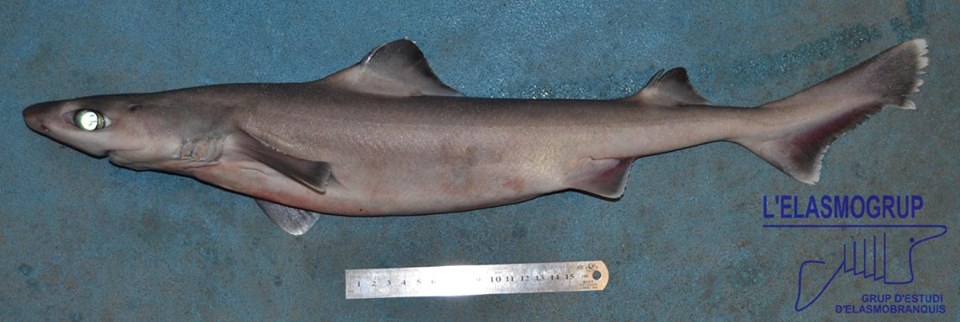
Centrophorus granulosus (Bloch & Schneider, 1801), juvenile male, 482 mm PCL, 601 mm TL, caught about 450 m depth, Gulf of Valencia (western Mediterranean) aprox. 39°30'N 00°15'E © LElasmogrup, University of Valencia)

Centrophorus granulosus (Bloch & Schneider, 1801), juvenile male, 482 mm PCL, 601 mm TL, caught about 450 m depth, Gulf of Valencia (western Mediterranean) aprox. 39°30'N 00°15'E © LElasmogrup, University of Valencia)
Common names
 Gekörnter Schlinghai,
Gekörnter Schlinghai,  Rauher Dornhai,
Rauher Dornhai,  Galludo manchado,
Galludo manchado,  Negra,
Negra,  Quelme,
Quelme,  Quelvacho,
Quelvacho,  Quelve,
Quelve,  Aiguillat gros yeux,
Aiguillat gros yeux,  Chien gris,
Chien gris,  Requin chagrin,
Requin chagrin,  Squale-chagrin commun,
Squale-chagrin commun,  Squalechagrin commun,
Squalechagrin commun,  Gulper shark,
Gulper shark,  Centroforo,
Centroforo,  Centroforo comune,
Centroforo comune,  Sagri,
Sagri,  Barroso,
Barroso,  Cação,
Cação,  Lixa granulosa,
Lixa granulosa,  Lixa-de-lei,
Lixa-de-lei,  Queime,
Queime,  Quelma,
Quelma,  Quelme,
Quelme,  Ramudo, Zaghrun (malta)
Ramudo, Zaghrun (malta)
 Gekörnter Schlinghai,
Gekörnter Schlinghai,  Rauher Dornhai,
Rauher Dornhai,  Galludo manchado,
Galludo manchado,  Negra,
Negra,  Quelme,
Quelme,  Quelvacho,
Quelvacho,  Quelve,
Quelve,  Aiguillat gros yeux,
Aiguillat gros yeux,  Chien gris,
Chien gris,  Requin chagrin,
Requin chagrin,  Squale-chagrin commun,
Squale-chagrin commun,  Squalechagrin commun,
Squalechagrin commun,  Gulper shark,
Gulper shark,  Centroforo,
Centroforo,  Centroforo comune,
Centroforo comune,  Sagri,
Sagri,  Barroso,
Barroso,  Cação,
Cação,  Lixa granulosa,
Lixa granulosa,  Lixa-de-lei,
Lixa-de-lei,  Queime,
Queime,  Quelma,
Quelma,  Quelme,
Quelme,  Ramudo, Zaghrun (malta)
Ramudo, Zaghrun (malta)
Short Description
Revised description after White et al. (2013) [20013]: A large (>1.5 m maximum total length) species of Centrophorus with the following combination of characters: body moderately robust (see Fig. 3); head moderately long (20.6–24.9% TL, 3.9–4.9 times in total length) and very robust; snout relatively short (horizontal preorbital length 4.8–8.1% TL) and moderately rounded in dorsal view; first dorsal fin low and long (height 4.4–6.5% TL, its soft length 11.0–16.6% TL), inner margin very long (more than length from insertion of exposed spine to fin insertion); second dorsal fin large, similar in height to first dorsal fin; pectoral fins large (anterior margin length 9.8–13.6% TL), free rear tip varying from slightly elongate in small individuals (free rear tip extension 0.9–2.2% TL in individuals <700 mm TL) to moderately elongate in adults (1.9–4.1% TL); lateral trunk denticles elevated on low, broad pedicel with strongly tricuspidate crowns in juveniles <700 mm TL; denticles of large individuals low, not on pedicels, crown tear-drop shaped with one long posterior cusp; upper teeth of juveniles <500 mm TL strongly oblique; upper teeth of individuals >700 mm TL with erect to slightly oblique cusps; lower teeth of all sizes much larger than upper teeth, strongly oblique, blade-like; body uniformly brownish (sometimes greyish to greyish brown), slightly paler ventrally; total vertebral centra 106–115;
Revised description after White et al. (2013) [20013]: A large (>1.5 m maximum total length) species of Centrophorus with the following combination of characters: body moderately robust (see Fig. 3); head moderately long (20.6–24.9% TL, 3.9–4.9 times in total length) and very robust; snout relatively short (horizontal preorbital length 4.8–8.1% TL) and moderately rounded in dorsal view; first dorsal fin low and long (height 4.4–6.5% TL, its soft length 11.0–16.6% TL), inner margin very long (more than length from insertion of exposed spine to fin insertion); second dorsal fin large, similar in height to first dorsal fin; pectoral fins large (anterior margin length 9.8–13.6% TL), free rear tip varying from slightly elongate in small individuals (free rear tip extension 0.9–2.2% TL in individuals <700 mm TL) to moderately elongate in adults (1.9–4.1% TL); lateral trunk denticles elevated on low, broad pedicel with strongly tricuspidate crowns in juveniles <700 mm TL; denticles of large individuals low, not on pedicels, crown tear-drop shaped with one long posterior cusp; upper teeth of juveniles <500 mm TL strongly oblique; upper teeth of individuals >700 mm TL with erect to slightly oblique cusps; lower teeth of all sizes much larger than upper teeth, strongly oblique, blade-like; body uniformly brownish (sometimes greyish to greyish brown), slightly paler ventrally; total vertebral centra 106–115;
Distribution
after White et al. (2013) [20013]: Centrophorus granulosus has a wide distribution in all ocean basins except the Eastern Pacific (Figure 10). Although its currently reported distribution is somewhat scattered, this is likely due to the difficulties in accurately identifying Centrophorus species. The distribution for C. granulosus given below is based on specimen records or published records that could be verified by images. Western Atlantic: reported from off Puerto Rico and the U.S. Virgin Islands in the Caribbean Sea; one specimen observed north of the Hudson Canyon, off New Jersey (L. Natanson, pers. comm.); from off Norfolk and Washington Canyons, Virginia (37.5° N) and off Cape Hatteras, North Carolina (34.5° N) to off southern Florida (26.5° N) in the U.S. Atlantic; from offshore of the Mississippi River Delta (90.5° W), off the Florida panhandle (Desoto Canyon), off Tampa Bay (26°55’ N, 84°53’ W) to the Florida Straits (Dry Tortugas, 83.8° W) in the Gulf of Mexico (Kiraly et al., 2003; Castro, 2011; Cotton, unpubl. data, as C. niaukang); reports of this species off Brazil (e.g. Soto, 2001) need to be confirmed and possibly are misidentifications; the image of this species in Uyeno et al. (1983) from off Suriname and French Guinea are not conspecific with the true C. granulosus. Eastern Atlantic: probably wide ranging but commonly confused with C. lusitanicus and C. niaukang in the literature; recorded from west of Scotland (57°40’ N, ZMH specimen); on the Galicia Bank, Spain (42°67’ N) (Bañón et al., 2008); off Sesimbra, Portugal (A. Veríssimo, pers. obs.); off the Canary Islands, North Africa (28° N) (specimens examined in this study; Brito, 2002); off Western Sahara (26° 10’ N) (Iglésias pers. comm.); SAM specimen collected off Saldanha, South Africa (32°16’ S). Western Indian: off KwaZulu-Natal in South Africa and Mozambique (Bass et al., 1986; Compagno et al., 1989, as C. lusitanicus; DAE unpubl. data); BMNH and HUJ specimens collected from off Providence Atoll, Cerf Island and Alphonse Group, Seychelles; CAS and CSIRO specimens collected from southern Madagascar Ridge and the South West Indian Ridge (36–39° S, 48–52° E); off the northeast end of Thaa and Laamu Atolls in the Maldives (~02°20’ N, 73°40’ E) (Adam et al., 1998, as C. niaukang). Eastern Indian & South-west Pacific: in Indonesia based on a specimen from off Cilacap, Central Java (~07°50’ S, 109°00’ E) and record from off Lombok (~08°50’ S, 116°35’ E) (White et al., 2006, as C. niaukang); in Australia, specimens from west of Dirk Hartog Island (26°05’ S) to west of Montebello Islands (20°25’ S) in Western Australia, and from off Wooli in New South Wales (29°58’ S) to northeast Queensland. North-west Pacific: from the East China Sea (30°35' N, 128°54' E) (Deng et al., 1985, as C. robustus); off eastern and southern Taiwan; in Japan from the Okinawa Trough (~25°30’ S) (Yano & Kugai, 1993, as C. niaukang) north to Sagami-Nada (~34°50’ S) (Nakabo, 2002, as C. acus). Recorded from depths of 98–1700 m (Nakabo, 2002; Last & Stevens, 2009). Source: www.gbif.org
after White et al. (2013) [20013]: Centrophorus granulosus has a wide distribution in all ocean basins except the Eastern Pacific (Figure 10). Although its currently reported distribution is somewhat scattered, this is likely due to the difficulties in accurately identifying Centrophorus species. The distribution for C. granulosus given below is based on specimen records or published records that could be verified by images. Western Atlantic: reported from off Puerto Rico and the U.S. Virgin Islands in the Caribbean Sea; one specimen observed north of the Hudson Canyon, off New Jersey (L. Natanson, pers. comm.); from off Norfolk and Washington Canyons, Virginia (37.5° N) and off Cape Hatteras, North Carolina (34.5° N) to off southern Florida (26.5° N) in the U.S. Atlantic; from offshore of the Mississippi River Delta (90.5° W), off the Florida panhandle (Desoto Canyon), off Tampa Bay (26°55’ N, 84°53’ W) to the Florida Straits (Dry Tortugas, 83.8° W) in the Gulf of Mexico (Kiraly et al., 2003; Castro, 2011; Cotton, unpubl. data, as C. niaukang); reports of this species off Brazil (e.g. Soto, 2001) need to be confirmed and possibly are misidentifications; the image of this species in Uyeno et al. (1983) from off Suriname and French Guinea are not conspecific with the true C. granulosus. Eastern Atlantic: probably wide ranging but commonly confused with C. lusitanicus and C. niaukang in the literature; recorded from west of Scotland (57°40’ N, ZMH specimen); on the Galicia Bank, Spain (42°67’ N) (Bañón et al., 2008); off Sesimbra, Portugal (A. Veríssimo, pers. obs.); off the Canary Islands, North Africa (28° N) (specimens examined in this study; Brito, 2002); off Western Sahara (26° 10’ N) (Iglésias pers. comm.); SAM specimen collected off Saldanha, South Africa (32°16’ S). Western Indian: off KwaZulu-Natal in South Africa and Mozambique (Bass et al., 1986; Compagno et al., 1989, as C. lusitanicus; DAE unpubl. data); BMNH and HUJ specimens collected from off Providence Atoll, Cerf Island and Alphonse Group, Seychelles; CAS and CSIRO specimens collected from southern Madagascar Ridge and the South West Indian Ridge (36–39° S, 48–52° E); off the northeast end of Thaa and Laamu Atolls in the Maldives (~02°20’ N, 73°40’ E) (Adam et al., 1998, as C. niaukang). Eastern Indian & South-west Pacific: in Indonesia based on a specimen from off Cilacap, Central Java (~07°50’ S, 109°00’ E) and record from off Lombok (~08°50’ S, 116°35’ E) (White et al., 2006, as C. niaukang); in Australia, specimens from west of Dirk Hartog Island (26°05’ S) to west of Montebello Islands (20°25’ S) in Western Australia, and from off Wooli in New South Wales (29°58’ S) to northeast Queensland. North-west Pacific: from the East China Sea (30°35' N, 128°54' E) (Deng et al., 1985, as C. robustus); off eastern and southern Taiwan; in Japan from the Okinawa Trough (~25°30’ S) (Yano & Kugai, 1993, as C. niaukang) north to Sagami-Nada (~34°50’ S) (Nakabo, 2002, as C. acus). Recorded from depths of 98–1700 m (Nakabo, 2002; Last & Stevens, 2009). Source: www.gbif.org
Human uses
fisheries: minor commercial; price category: high; price reliability: reliable: based on ex-vessel price for this species
fisheries: minor commercial; price category: high; price reliability: reliable: based on ex-vessel price for this species
Biology
Ovoviviparous, embryos feed solely on yolk [733]. Young are born from 30 to 42 cm or more [518]. Distinct pairing with embrace [17086]. A common deepwater dogfish of the outer continental shelves and upper slopes, commonest below 200 m [518]. Solitary [20078]. Also mesopelagic [17657]. Feeds mainly on bony fishes such as hake, epigonids and lanternfish [518].
Ovoviviparous, embryos feed solely on yolk [733]. Young are born from 30 to 42 cm or more [518]. Distinct pairing with embrace [17086]. A common deepwater dogfish of the outer continental shelves and upper slopes, commonest below 200 m [518]. Solitary [20078]. Also mesopelagic [17657]. Feeds mainly on bony fishes such as hake, epigonids and lanternfish [518].
Size / Weight / Age
The females and males examined in this study ranged in length from 321–1650 mm and 308–1237 mm , 12 near-term embryos were examined in this study ranging from 350–420 mm TL; newborn individuals with yolk-sac scars ranged from 378 to 393 mm TL. [20013]
The females and males examined in this study ranged in length from 321–1650 mm and 308–1237 mm , 12 near-term embryos were examined in this study ranging from 350–420 mm TL; newborn individuals with yolk-sac scars ranged from 378 to 393 mm TL. [20013]
Habitat
bathydemersal; marine; depth range 50 - 1440 m, usually 200 - 600 m
bathydemersal; marine; depth range 50 - 1440 m, usually 200 - 600 m
Remarks
shark-references Species-ID=1238; Taxonomic Remarks: The nomenclature of the genus is under revision. This species that inhabits the Mediterraneann Sea will be named probably soon C. uyato. (pers. comment Javier Guallart; Redescription of C. granulosus of White et al. (2013) [20013].
shark-references Species-ID=1238; Taxonomic Remarks: The nomenclature of the genus is under revision. This species that inhabits the Mediterraneann Sea will be named probably soon C. uyato. (pers. comment Javier Guallart; Redescription of C. granulosus of White et al. (2013) [20013].
Parasites (arranged by Jürgen Pollerspöck)
Cestoda
Copepoda
Cestoda
- Grillotia scolecina (Rudolphi, 1819) [16112]
- Grillotia sp. [16112]
- Sphyriocephalus viridis (Wagener, 1854) Pintner, 1913 [16112] [25091]
Copepoda
- Eudactylina valei Nunes-Ruivo, 1956 [15303]
- Neoalbionella benzipirata Ruiz, Driggers & Bullard, 2019 [27139]








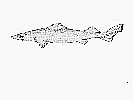
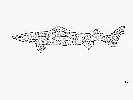
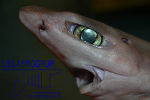
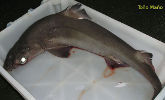

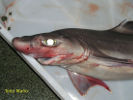
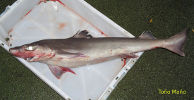
(in_MUELLER&HENLE,1839).jpg)
